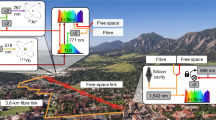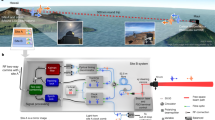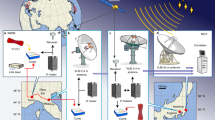Abstract
Within the last decade, optical atomic clocks have surpassed the best cesium clocks, which are used to realize the unit of time and frequency, in terms of accuracy and stability by about two orders of magnitude. When remote optical atomic clocks are connected by links without degradation in the clock signals, an optical clock network is formed, with distinct advantages for the dissemination of time, geodesy, astronomy and basic and applied research. Different approaches for time and frequency transfer in the microwave and optical regime, via satellites and free-space links, optical fibre links, or transportable optical atomic clocks, can be used to form a hybrid clock network that may allow a future redefinition of the unit of time based on an optical reference transition.
This is a preview of subscription content, access via your institution
Access options
Access Nature and 54 other Nature Portfolio journals
Get Nature+, our best-value online-access subscription
$29.99 / 30 days
cancel any time
Subscribe to this journal
Receive 12 print issues and online access
$209.00 per year
only $17.42 per issue
Buy this article
- Purchase on Springer Link
- Instant access to full article PDF
Prices may be subject to local taxes which are calculated during checkout




Similar content being viewed by others
References
Lewandowski, W. & Arias, E. F. GNSS times and UTC. Metrologia 48, S219–S224 (2011).
International Telecommunication Union ITU-T Recommendation ITU-T G.8271.1/Y.1366.1: Network Limits for Time Synchronization (ITU, 2013).
Dzuba, V. A. et al. Strongly enhanced effects of Lorentz symmetry violation in entangled Yb+ ions. Nat. Phys. 12, 465–468 (2016).
Altschul, B. et al. Quantum tests of the Einstein equivalence principle with the STE–QUEST space mission. Adv. Space Res. 55, 501–524 (2015).
Uzan, J.-P. Varying constants, gravitation and cosmology. Living Rev. Relativity 14, 2 (2011).
Flury, J. Relativistic geodesy. J. Phys. Conf. Ser. 723, 012051 (2016).
Lorimer, D. R. Binary and millisecond pulsars. Living Rev. Relativity 11, 8 (2008).
Arzumanian, Z. The NANOGrav nine-year data set: observations, arrival time measurements, and analysis of 37 millisecond pulsars. Astrophys. J. 813, 65 (2015).
Poli, N., Oates, C. W., Gill, P. & Tino, G. M. Optical atomic clocks. Rivista del Nuovo Cimento 36, 555–624 (2013).
Ludlow, A. D., Boyd, M. M., Ye, J., Peik, E. & Schmidt, P. O. Optical atomic clocks. Rev. Mod. Phys. 87, 637–701 (2015).
Nicholson, T. L. et al. Systematic evaluation of an atomic clock at 2 × 10−18 total uncertainty. Nat. Commun. 6, 6896 (2015).
Ushijima, I., Takamoto, M., Das, M., Ohkubo, T. & Katori, H. Cryogenic optical lattice clocks. Nat. Photon. 9, 185–189 (2015).
Huntemann, N., Sanner, C., Lipphardt, B., Tamm, C. & Peik, E. Single-ion atomic clock with 3 × 10−18 systematic uncertainty. Phys. Rev. Lett. 116, 063001 (2016).
Hinkley, N. et al. An atomic clock with 10−18 instability. Science 341, 1215–1218 (2013).
Al-Masoudi, A., Dörscher, S., Häfner, S., Sterr, U. & Lisdat, C. Noise and instability of an optical lattice clock. Phys. Rev. A 92, 063814 (2015).
Fortier, T. M. et al. Precision atomic spectroscopy for improved limits on variation of the fine structure constant and local position invariance. Phys. Rev. Lett. 98, 070801 (2007).
Blatt, S. et al. New limits on coupling of fundamental constants to gravity using 87Sr optical lattice clocks. Phys. Rev. Lett. 100, 140801 (2008).
Godun, R. M. et al. Frequency ratio of two optical clock transitions in 171Yb+ and constraints on the time-variation of fundamental constants. Phys. Rev. Lett. 113, 210801 (2014).
Huntemann, N. et al. Improved limit on a temporal variation of m p /m e from comparisons of Yb+ and Cs atomic clocks. Phys. Rev. Lett. 113, 210802 (2014).
Bjerhammar, A. On a relativistic geodesy. Bull. Géodésique 59, 207–220 (1985).
Gill, P. Is the time right for a redefinition of the second by optical atomic clocks? J. Phys. Conf. Ser. 723, 012053 (2016).
Grebing, C. et al. Realization of a timescale with an accurate optical lattice clock. Optica 3, 563–569 (2015).
Ido, T., Hachisu, H., Nakagawa, F. & Hanado, Y. Rapid evaluation of time scale using an optical clock. J. Phys. Conf. Ser. 723, 012041 (2016).
Droste, S. et al. Characterization of a 450 km baseline GPS carrier-phase link using an optical fiber link. New J. Phys. 17, 083044 (2015).
Petit, G. et al. 1 × 10−16 frequency transfer by GPS PPP with integer ambiguity resolution. Metrologia 52, 301–309 (2015).
Bauch, A. Time and frequency comparisons using radiofrequency signals from satellites. C. R. Physique 16, 471–479 (2015).
Hachisu, H. et al. Direct comparison of optical lattice clocks with an intercontinental baseline of 9000 km. Opt. Lett. 39, 4072–4075 (2014).
Margolis, H. et al. International timescales with optical clocks. In Proc. 2013 Joint UFFC, EFTF PFM Symp. 908–911 (IEEE, 2013).
Fujieda, M. et al. Carrier-phase two-way satellite frequency transfer over a very long baseline. Metrologia 51, 253–262 (2014).
Fujieda, M., Gotoh, T. & Amagai, J. Advanced two-way satellite frequency transfer by carrier-phase and carrier-frequency measurements. J. Phys. Conf. Ser. 723, 012036 (2016).
Laurent, Ph., Massonnet, D., Cacciapuoti, L. & Salomon, C. The ACES/PHARAO space mission: La mission spatiale ACES/Pharao. C.R. Physique 16, 540–552 (2015).
Schäfer, W. & Feldmann, T. Perspectives of time and frequency transfer via satellite. J. Phys. Conf. Ser. 723, 012038 (2016).
Huang, Y.-J. & Tsao, H.-W. Design and evaluation of an open-loop receiver for TWSTFT applications. IEEE Trans. Instrum. Meas. 64, 1553–1558 (2015).
Samain, E. et al. Time transfer by laser link: a complete analysis of the uncertainty budget. Metrologia 52, 423–432 (2015).
Rovera, G. D. et al. A direct comparison between two independently calibrated time transfer techniques: T2L2 and GPS common-views. J. Phys. Conf. Ser. 723, 012037 (2016).
Schreiber, K. U. et al. Ground-based demonstration of the European Laser Timing (ELT) experiment. IEEE Trans. Ultrasonics, Ferroelectrics, Frequency Control 57, 728–737 (2010).
Cacciapuoti, L. & Salomon, C. Atomic clock ensemble in space. J. Phys. Conf. Ser. 327, 012049 (2011).
Djerroud, K. et al. Coherent optical link through the turbulent atmosphere. Opt. Lett. 35, 1479–1481 (2010).
Robert, C., Conan, J.-M. & Wolf, P. Impact of turbulence on high-precision ground-satellite frequency transfer with two-way coherent optical links. Phys. Rev. A 93, 033860 (2016).
Deschênes, J.-D. et al. Synchronization of distant optical clocks at the femtosecond level. Phys. Rev. X 6, 021016 (2016).
Yamaguchi, A. et al. Direct comparison of distant optical lattice clocks at the 10−16 uncertainty. Appl. Phys. Express 4, 082203 (2011).
Predehl, K. et al. A 920-kilometer optical fiber link for frequency metrology at the 19th decimal place. Science 336, 441–444 (2012).
Lopez, O. et al. Ultra-stable long distance optical frequency distribution using the Internet fiber network. Opt. Express 20, 23518–23526 (2012).
Rost, M. et al. Time transfer through optical fibers over a distance of 73 km with an uncertainty below 100 ps. Metrologia 49, 772–778 (2012).
Śliwczyński, Ł., Krehlik, P., Czubla, A., Buczek, Ł. & Lipiński, M. Dissemination of time and RF frequency via a stabilized fibre optic link over a distance of 420 km. Metrologia 50, 133–145 (2013).
Calonico, D. et al. High-accuracy coherent optical frequency transfer over a doubled 642-km fiber link. Appl. Phys. B 117, 979–986 (2014).
Chiodo, N. et al. Cascaded optical fiber link using the Internet network for remote clocks comparison. Opt. Express 23, 33927–33937 (2015).
Raupach, S. M. F., Koczwara, A. & Grosche, G. Brillouin amplification supports 10−20 accuracy in optical frequency transfer over 1400 km of underground fibre. Phys. Rev. A 92, 021801(R) (2015).
Ma, L.-S., Jungner, P., Ye, J. & Hall, J. L. Delivering the same optical frequency at two places: accurate cancellation of phase noise introduced by optical fiber or other time-varying path. Opt. Lett. 19, 1777–1779 (1994).
Jiang, H. et al. Transfer of an optical frequency over an urban fiber link. J. Opt. Soc. Am. B 25, 2029–2035 (2008).
Williams, P. A., Swann, W. C. & Newbury, N. R. High-stability transfer of an optical frequency over long fiber-optic links. J. Opt. Soc. Am. B 25, 1284–1293 (2008).
Grosche, G. et al. Optical frequency transfer via 146 km fiber link with 10−19 relative accuracy. Opt. Lett. 34, 2270–2272 (2009).
Akatsuka, T. et al. 30-km-long optical fiber link at 1397 nm for frequency comparison between distant strontium optical lattice clocks. Jpn. J. Appl. Phys. 53, 032801 (2014).
Lopez, O. et al. Simultaneous remote transfer of accurate timing and optical frequency over a public fiber network. Appl. Phys. B 110, 3–6 (2013).
Lisdat, C. et al. A clock network for geodesy and fundamental science. Nat. Commun. 7, 12443 (2016).
Bercy, A. et al. Two-way optical frequency comparisons at 5 × 10−21 relative stability over 100-km telecommunication network fibers. Phys. Rev. A 90, 061802(R) (2014).
Vogt, S. et al. A transportable optical lattice clock. J. Phys. Conf. Ser. 723, 012020 (2016).
Poli, N. et al. A transportable strontium optical lattice clock. Appl. Phys. B 117, 1107–1116 (2014).
Bongs, K. et al. Development of a strontium optical lattice clock for the SOC mission on the ISS. C.R. Physique 16, 553–564 (2015).
Cao, J. et al. A transportable 40Ca+ single-ion clock with 7.7 × 10−17 systematic uncertainty. Preprint at http://lanl.arxiv.org/abs/1607.03731v1 (2016).
Hong, F.-L. et al. Measuring the frequency of a Sr optical lattice clock using a 120 km coherent optical transfer. Opt. Lett. 34, 692–694 (2009).
Akatsuka, T. et al. 30-km-long optical fiber link at 1397 nm for frequency comparison between distant strontium optical lattice clocks. Jpn. J. Appl. Phys. 53, 032801 (2014).
Ye, J. et al. Delivery of high-stability optical and microwave frequency standards over an optical fiber network. J. Opt. Soc. Am. B 20, 1459–1467 (2003).
Williams, P. A., Swann, W. C. & Newbury, N. R. High-stability transfer of an optical frequency over long fiber-optic links. J. Opt. Soc. Am. B 25, 1284–1293 (2008).
Bureau International des Poids et Mesures http://www.bipm.org/en/bipm-services/timescales/time-ftp/Circular-T.html (last download July 2016).
Bureau International des Poids et Mesures Recommendation 1 (CI-2006): Concerning Secondary Representations of the Second 249–250 (95th meeting, October 2006); http://www.bipm.org/en/committees/cipm/publications-cipm.html (last download 1 June 2016).
Gill, P. When should we change the definition of the second? Phil. Trans. R. Soc. A 369, 4109–4130 (2012).
Riehle, F. Towards a redefinition of the second based on optical atomic clocks. C.R. Physique 16, 506–515 (2015).
Wolf, P. et al. Comparing high accuracy frequency standards via TAI. In 20th European Frequency Time Forum 476–485 (IEEE, 2006).
Le Targat, R. et al. Experimental realization of an optical second with strontium lattice clocks. Nat. Commun. 4, 2109 (2013).
Grebing, C. et al. Realization of a timescale with an accurate optical lattice clock. Optica 3, 563–569 (2016).
Ido, T., Hachisu, H., Nakagawa, F. & Hanado, Y. Rapid evaluation of time scale using an optical clock. J. Phys. Conf. Ser. 723, 012041 (2016).
Pavlis, N. K. & Weiss, M. A. The relativistic redshift with 3 × 10−17 uncertainty at NIST, Boulder, Colorado, USA. Metrologia 40, 66–73 (2003).
Grosche, G. Eavesdropping time and frequency: phase noise cancellation along a time-varying path, such as an optical fiber. Opt. Lett. 39, 2545–2548 (2014).
Ludlow, A. et al. Sr lattice clock at 1 × 10−16 fractional uncertainty by remote optical evaluation with a Ca clock. Science 319, 1805–1808 (2008).
Chanteau, B. et al. Mid-infrared laser phase-locking to a remote near-infrared frequency reference for high-precision molecular spectroscopy. New J. Phys. 15, 073003 (2013).
Lopez, O. et al. Frequency and time transfer for metrology and beyond using telecommunication network fibres. C.R. Physique 16, 531–539 (2015).
Calonico, D. et al. High-accuracy coherent optical frequency transfer over a doubled 642-km fiber link. Appl. Phys. B 117, 979–986 (2014).
Friebe, J. et al. Remote frequency measurement of the 1S0 -3P1 transition in laser-cooled 24Mg. New J. Phys. 13, 125010 (2011).
Matveev, A. et al. Precision measurement of the hydrogen 1S-2S frequency via a 920-km fiber link. Phys. Rev. Lett. 110, 230801 (2013).
Chou, C. W., Hume, D. B., Rosenband, T. & Wineland, D. J. Optical clocks and relativity. Science 329, 1630–1633 (2010).
Soffel, M. et al. The IAU 2000 resolutions for astrometry, celestial mechanics, and metrology in the relativistic framework: explanatory supplement. Astron. J. 126, 2687–2706 (2003).
Takano, T. et al. Geopotential measurements with synchronously linked optical lattice clocks. Nat. Photon. 10, 662–666 (2016).
King, M. A. et al. Lower satellite-gravimetry estimates of Antarctic sea-level contribution. Nature 491, 586–589 (2012).
Pail, R. et al. GOCE-only gravity field model derived from 8 months of GOCE data. In Proc. 4th Int. GOCE User Workshop SP-696 (ed. Ouwehand, L.) 17–23 (European Space Agency, 2011).
Sheard, B. et al. Intersatellite laser ranging instrument for the GRACE Follow-on mission. J. Geod. 86, 1083–1095 (2012).
Filippi, G. et al. The ALMA high speed optical communication link is here. An essential component for reliable present and future operations; https://www.eso.org/sci/libraries/SPIE2016/9913-83.pdf
Doeleman, S. et al. Adapting a cryogenic sapphire oscillator for very long baseline interferometry. Publ. Astron. Soc. Pacif. 123, 582–595 (2011).
Clivati, C. et al. A coherent fiber link for very large baseline interferometry. IEEE Trans. Ultrasonics Ferroelectrics Frequency Control 62, 1907–1912 (2015).
ESA's Deep Space Tracking Network (European Space Agency); http://download.esa.int/esoc/estrack/esa_estrack_brochure_2015_EN.pdf
Schiller, S. Feasibility of giant fiber-optic gyroscopes. Phys. Rev. A 87, 033823 (2013).
Clivati, C. et al. Large-area fiber-optic gyroscopes on a multiplexed fiber network. Opt. Lett. 38, 1092–1094 (2013).
Derevianko, A. & Pospelov, M. Hunting for topological dark matter with atomic clocks. Nat. Phys. 10, 933–936 (2014).
Stadnik, Y. V. & Flambaum, V. V. Enhanced effects of variation of the fundamental constants in laser interferometers and application to dark matter detection. Phys. Rev. A 93, 063630 (2016).
Matei, D. G. et al. A second generation of low thermal noise cryogenic silicon resonators. J. Phys. Conf. Ser. 723, 012031 (2016).
Abbott, B. P. et al. (LIGO Scientific Collaboration and Virgo Collaboration) Observation of gravitational waves from a binary black hole merger. Phys. Rev. Lett. 116, 061102 (2016).
Pustelny, S. et al. The Global Network of Optical Magnetometers for Exotic Physics (GNOME): a novel scheme to search for physics beyond the standard model. Ann. Phys. 525, 659–670 (2013).
Kómár, P. et al. A quantum network of clocks. Nat. Phys. 10, 582–587 (2014).
Polzik, E. & Ye, J. Entanglement and spin squeezing in a network of distant optical lattice clocks. Phys. Rev. A 93, 021404(R) (2016).
Kolkowitz, S. et al. Gravitational wave detection with optical lattice atomic clocks. Preprint at http://lanl.arxiv.org/abs/1606.01859v2 (2016).
Ma, L.-S. et al. International comparisons of femtosecond laser frequency combs. IEEE Trans. Instrum. Meas. 54, 746–749 (2005).
Rosenband, T. et al. Frequency ratio of Al+ and Hg+ single-ion optical clocks; metrology at the 17th decimal place. Science 319, 1808–1812 (2008).
Yamanaka, K., Ohmae, N., Ushijima, I., Takamoto, M. & Katori, H. Frequency ratio of 199Hg and 87Sr optical lattice clocks beyond the SI limit. Phys. Rev. Lett. 114, 230801 (2015).
Nemitz, N. et al. Frequency ratio of Yb and Sr clocks with 5 × 10−17 uncertainty at 150 s averaging time. Nat. Photon. 10, 258–261 (2016).
Sullivan, D., Allan, D., Howe, D. & Walls, F. (eds) NIST Technical Note 1337: Characterization of Clocks and Oscillators (NIST, US Department of Commerce, National Institute of Standards and Technology, 1990); http://tf.boulder.nist.gov/general/pdf/868.pdf
Rubiola, E. On the measurement of frequency and of its sample variance with high-resolution counters. Rev. Sci. Instrum. 76, 054703 (2005).
Itano, W. M. et al. Quantum projection noise: population fluctuations in two-level systems. Phys. Rev. A 47, 3554–3570 (1993).
Acknowledgements
The author thanks H. Schnatz, N. Huntemann, D. Piester, G. Grosche and U. Sterr for their valuable comments and suggestions.
Author information
Authors and Affiliations
Corresponding author
Ethics declarations
Competing interests
The author declares no competing financial interests.
Rights and permissions
About this article
Cite this article
Riehle, F. Optical clock networks. Nature Photon 11, 25–31 (2017). https://doi.org/10.1038/nphoton.2016.235
Received:
Accepted:
Published:
Issue Date:
DOI: https://doi.org/10.1038/nphoton.2016.235
This article is cited by
-
Communications with guaranteed bandwidth and low latency using frequency-referenced multiplexing
Nature Electronics (2023)
-
Fission free high-energy mode-locked soliton generation in an all-polarization-maintaining fiber laser
Applied Physics B (2022)
-
Simultaneous bicolor interrogation in thulium optical clock providing very low systematic frequency shifts
Nature Communications (2021)
-
A low-noise photonic heterodyne synthesizer and its application to millimeter-wave radar
Nature Communications (2021)
-
Optically synchronized fibre links using spectrally pure chip-scale lasers
Nature Photonics (2021)



